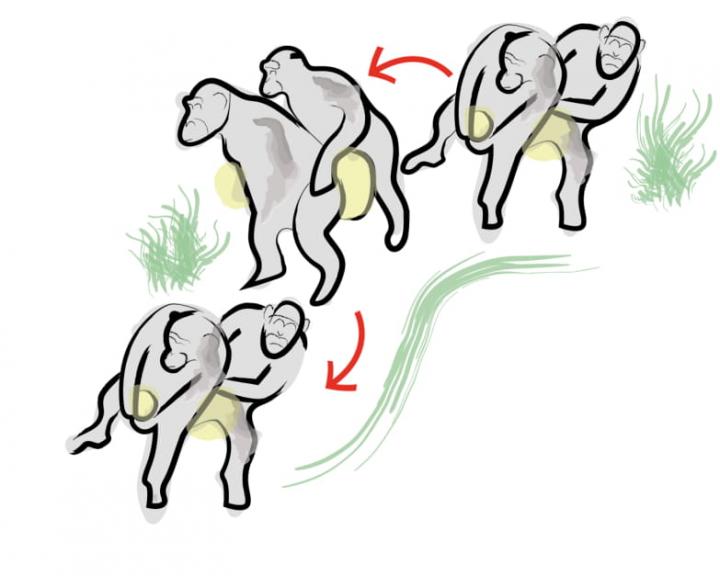
Credit: University of Warwick
- The evolution of human dance has been studied by psychologists in chimpanzees
- Researchers from the University of Warwick, Durham University and Free University of Brussels found two chimpanzees performed a duo dance-like behaviour, similar to a conga-line
- Behaviours displayed by the chimpanzees forces an interest in the evolution of dance as humans are no longer the only ape species where it takes two individuals to tango.
Psychologist observing two chimpanzees in a zoo have discovered that they performed a behaviour hitherto never seen, they coordinated together in a rhythmic social ritual.
Two chimpanzees housed in a zoo in the US have sparked the question about how human dance evolved after being observed performing a duo dance-like behaviour, similar to a human conga-line.
In the paper ‘Coupled whole-body rhythmic entrainment between two chimpanzees’ published today, the 12th of December in the Journal Scientific Reports, researchers led by the University of Warwick found the levels of motoric co-ordination, synchrony and rhythm between the two female chimpanzees matched the levels shown by orchestra players performing the same musical piece.
Other species have been shown to be able to entertain by moving to the pace of a rhythmic tempo by an external stimulus and solo individuals, however this is the first time it hasn’t been triggered by nonhuman partners or signals.
Although the newly described behaviour probably represents a new form a stereotypy in captivity in this great ape species, the behaviour forces scientists interested in the evolution of human dance to consider new conditions that may have catalysed the emergence of one of human’s most exuberant and richest forms of expression.
Dr Adriano Lameira, from the Department of Psychology at the University of Warwick comments:
“Dance is an icon of human expression. Despite astounding diversity around the world’s cultures and dazzling abundance of reminiscent animal systems, the evolution of dance in the human clade remains obscure.
“Dance requires individuals to interactively synchronize their whole-body tempo to their partner’s, with near-perfect precision, this explains why no dance forms were present amongst nonhuman primates. Critically, this is evidence for conjoined full-body rhythmic entrainment in great apes that could help reconstruct possible proto-stages of human dance is still lacking.”
The researchers report an endogenously-effected case of ritualized dance-like behaviour between two captive chimpanzees – synchronized bipedalism. By studying videos they revealed that synchronisation between individuals was non-random, predictable, phase concordant, maintained with instantaneous centi-second precision and jointly regulated, with individuals also taking turns as “pace-makers”.
###
12 DECEMBER 2019
NOTES TO EDITORS
High-res images available at: https:/
Paper available to view once embargo lifted at: http://www.
DOI: 10.1038/s41598-019-55360-y
FOR FURTHER INFORMATION PLEASE CONTACT:
Alice Scott
Media Relations Manager – Science
University of Warwick
Tel: +44 (0) 2476 574 255 or +44 (0) 7920 531 221
E-mail: [email protected]
Media Contact
Alice Scott
[email protected]
07-920-531-221
Original Source
https:/
Related Journal Article
http://dx.




